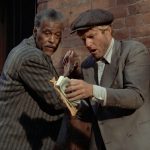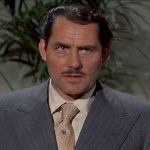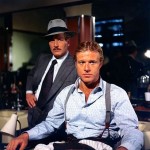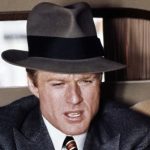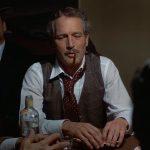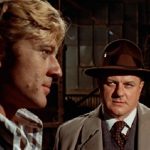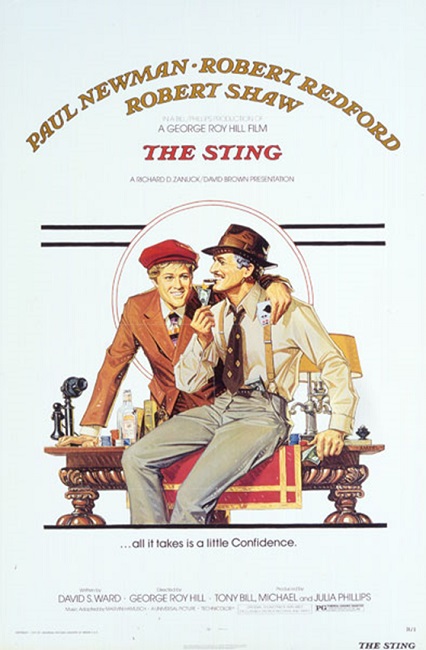
The Sting – 1973
The “sting” refers to the moment when a con artist successfully takes a mark’s money. The big pay-off, the grand finale, the moment of victory! But in this case, the sting was the big twist in the end of the plot. It got me!
This was a good movie on multiple levels. True, it was not a grand epic, but it was devilishly clever and well written. Our two lead actors, Robert Redford and Paul Newman both did a great job. And, of course, Robert Shaw, who you might remember from A Man For All Seasons, did a fantastic job as the bad guy. Actress Eileen Brennan, and actors Charles Durning, Harold Gould, Ray Walston, and Dana Elcar all did a great job rounding out the cast.
Just like a good con should, the film did a great job of drawing me in, making me believe everything I was told, and then pulling the old switcheroo at the end. They got the drop on me, and yet even after it was all over, I still bought it, hook, line, and sinker. The real star of The Sting was David S. Ward, who won his Academy Award for Best Original Screenplay. The plot was so cleverly written.
Interesting note: The film was nominated for 11 Academy Awards and won 7. This was the 46th academy awards where the anonymous streaker, later identified as Robert Opel, ran across the stage, naked, at the Academy Awards ceremony. Presenter David Niven, didn’t miss a beat and quipped, “Isn’t it fascinating to think that probably the only laugh that man will ever get in his life is by stripping off and showing his shortcomings?”
But back to the film… Robert Redford played Johnny Hooker, a grifter, or small time con-man. As the film opens, he and his partner Luther Coleman, played by Robert Earl Jones (Yes, you guessed it: Father of James Earl Jones), successfully con a man out of $11,000.00. Unfortunately, their victim was a numbers racketeer for ruthless crime boss, Doyle Lonnegan, played by Robert Shaw. Lonnegan ends up killing Luther and putting a hit out on Hooker for stealing his money.
Hooker goes to Chicago to find Henry Gondorff, once a big-time con artist, now hiding in obscurity from the FBI. When the two meet, the real fun begins. The rest of the film shows the great lengths the two go to in order to con Lonnegan out of all his money. For Gondorff, it is the money he is after. For Hooker, it is revenge on Lonnegan for Luther’s murder. Thus the scheme is hatched.
Robert Redford and Paul Newman have a natural on-screen chemistry that is easy to see. They seem to play off each other in a way that is easy and enjoyable to watch. Of course, this duo had already proven this to be true in their previous collaboration, Butch Cassidy and the Sundance Kid, which had also been nominated for Best Picture in 1969, although it did not win.
Redford is not only easy on the eyes, he has an ease about his acting. It all seemed real, almost as if he wasn’t acting at all, but playing himself. Newman didn’t have as much of that same quality, but Redford seemed to bring it out in him. Together, they created believable characters that complimented each other very well.
I found Robert Shaw’s performance adequate, though after seeing him as King Henry VIII in A Man For All Seasons, I think I liked him better wearing a crown. He was supposed to be an Irish man, though his accent wasn’t very consistent. It would come and go over the course of the film. And I’m not sure whether it was a conscious choice for the role, but he played the character of Doyle Lonnegan as very subdued which sometimes translated into the appearance of low energy. Maybe this was his interpretation of the serious and dangerous mobster boss.
Eileen Brennan was cast in the role of Billie, Gondorff’s girlfriend who helped him on his big plan. The part was fairly minor, but she was memorable in it. She was pretty, though not gorgeous, and had a personal ease in her acting style as well, though with her (as compared to Redford), it seemed more practiced than natural. I must concede, though, that her role was memorable partly because it was really the only significant female role in the film. The only other was an assassin hired by Lonnegan to kill Hooker called Loretta Salino, played by Dimitra Arliss. She had even less screen time.
One more actor I have to comment on is Ray Walston, only to say that he apparently does not age. He looked exactly the same in this 1973 film as he did when he died in 2001. Just a few more wrinkles.
Director George Roy Hill did a great job of giving the film an air of playfulness despite all the crime: the murders, the cons, the deceptions, the assassins, the danger. He used several effective ways of accomplishing this. First, is the way the entire movie, itself, is constructed. Hill split it up into several separate and distinct parts that were each introduced with a hand drawn picture that looked like they might have come out of a 1930s newspaper. Each section also had its own title. Doing this, he made each section like a little vignette that would help move the story along to its conclusion.
While these little introductions were on the screen, music would play like the music of a silent film playing over dialogue cards. And the music of this film was something special. Composer Scott Joplin was known for his ragtime music that was energetic, fun, playful, and catchy. This more than anything gave the movie its cheeky and light-hearted feel. Several Joplin tunes were used on the soundtrack, adapted by Marvin Hamlisch. The most famous of these was the main theme of the movie “The Entertainer.”
Interesting note: Even though the movie took place in the 1936, Joplin’s music was actually written around the turn of the century. The Entertainer was written in 1902, but it did a fantastic job of giving the film a 1936 feel.
And finally, the ending of the film was particularly satisfying. Everyone got what they deserved. Gondorff proved that he was smarter than everyone else and the con worked perfectly as planned. It worked so well, in fact, that when the sting took place, Lonnagen walked away from his money without ever even knowing that he had been conned. It was such a clever scheme that could only have worked in the 1930s. The technology of today would, of course, quickly blow it out of the water. But in 1936, I thought it a very believable plot.
This was a good movie. It was entertaining and fun, and Redford and Newman both did a fine job. And darn it if that Joplin tune, The Entertainer, wasn’t stuck in my head after the movie was over. All in all, it was a good addition to the list of Best Picture winners.
